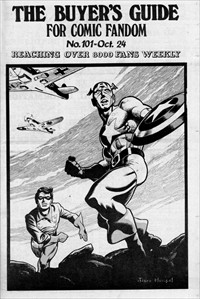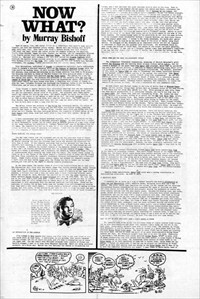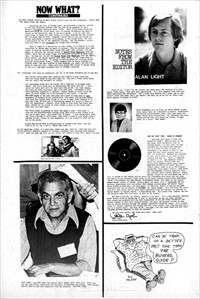The Buyer's Guide to Comic Fandom
Publisher Alan Light started the Buyer's Guide to Comic Fandom in 1971, and in 1975 it had just shifted to weekly issues, with 8000 subscriptions. It was primarily an "adzine"- almost every page was adverts, with just a few comic and editorial pages. In 1983 it was sold to a commercial publisher, and continued in print to issue 1699, in March 2013. The series had a brief mention in the "Now what?" column by Murray Bishoff in issue 101, dated 24 October 1975, on page 28 (with a small photo on page 29).



SPACE 1999 AND THE BUCK ROGERS/BOGART EFFECT
The Independent Television Corporation, producers of Patrick McGoohan's great series The Prisoner and the terribly droll science fiction series U.F.0., has released a package of two dozen hour-long Space 1999 programs, which cost an estimated six and a half million dollars, in addition to massive advertising costs which netted 150 stations, almost all of which have network affiliations. Abe Mandell, president of ITC, tells us "Space 1999 was able to 'breakaway' and create television because of the network calibre, network quality of the series- the conviction that Space 1999 can get winning ratings against network prime time programming." We can only admire an outfit that pumps a phenomenal amount of money into a television series, hires 2001 special effects man Brian Johnson to excite the audience, and even contracts an internationally renowned fashion designer, Rudi Gernreich, to create the twenty-first century in cloth. ITC took a calculated and very expensive risk.
We best recall star Michael Landau in his role of Rollin Hand on Mission: Impossible, and his co-star Chicago-born Barbara Bain as. Cinnamon Garter in the same series, a role which won her three Emmy awards in a row. While married in real life, these two make better protagonists as an unattached twosome, and that's how they play it in Space 1999. Off camera they lead very interesting lives. Mr. Landau has made films, written film scripts, worked as an artist for the New York Daily News, paints, and likes to cook Japanese food. Mrs. Landau needlepoints rugs in her spare time. The couple recently moved back to California after living in London for two years, since their acting careers seem to pull them back to the U.S. Their closest friends include Carl and Estelle Reiner and Mel Brooks. "We're like family," said Mrs. Landau. "We all landed in Hollywood about the same time and adopted each other. We spend all the holidays together." Company like that would even stimulate a comic book collector.
Space 1999 does not have guaranteed success. Gerry and Sylvia Anderson, who supervised the production, have again failed to overcome the British television formula of minimized acting. As one friend put it to me, "Barbara Bain does an excellent job portraying an automaton." I can't exactly agree, but I must admit American audiences want to see personalities comparable to those in Star Trek, and nothing less. A critical viewer may ask "What can Space 1999 do that Star Trek didn't do?", and that brings me to what I call the Buck Rogers Effect. In five years Buck Rogers had established the space opera formula, and after ten years that strip had tried almost every science fiction motif conceivable. Where could anyone go from there? Alex Raymond used epic storytelling, unrivalled artwork, better developed characters, and expanded use of old themes to make Flash Gordon succeed, but science fiction-wise he did not surpass Buck Rogers. Less qualified craftsmen, like the men who handled Don Dixon, could only imitate and not innovate. The advent of television offered science fiction a new door, and so came the Twilight Zone, the Outer Limits, Lost in Space (a sentimental favourite of mine), and Star Trek. These programmes again tried all the themes, and reruns of Star Trek have kept them fresh in our minds. Space 1999 must battle the Buck Rogers Effect on television and may not win. The plots of the first few programs show room for improvement. However, the same television mediocrity that has preserved the Beverly Hillbillies will probably enable Space 1999 to stay with us for several years.
You may recall certain advertising claimed Space 1999 would replace Star Trek in the hearts of television viewers. That won't happen because of the Bogart Effect. Simply put, the Bogart Effect means people have certain emotions tied to the television series, movies, and various people they have come to love. even though another version or personality may come along and do a better job, love for the original will keep its popularity on top. No one will ever replace Humphrey Bogart, not because others don't look better or act better, but because fans love Humphrey Bogart irrationally. He was a "one-and-only." The same goes for Star Trek lovers. They don't care how good Space 1999 is, its not the same and that's that. Space 1999 will have to gather its own cult if it wants to compare with Star Trek, but the die-in-the-wool Trekkies will remain firm.
Despite these restrictions, Space 1999 could make a strong contribution to mid-seventies television. We wish it well.
There is an optical illusion called the Bogart Effect, based on a negative image of Humphrey Bogart.